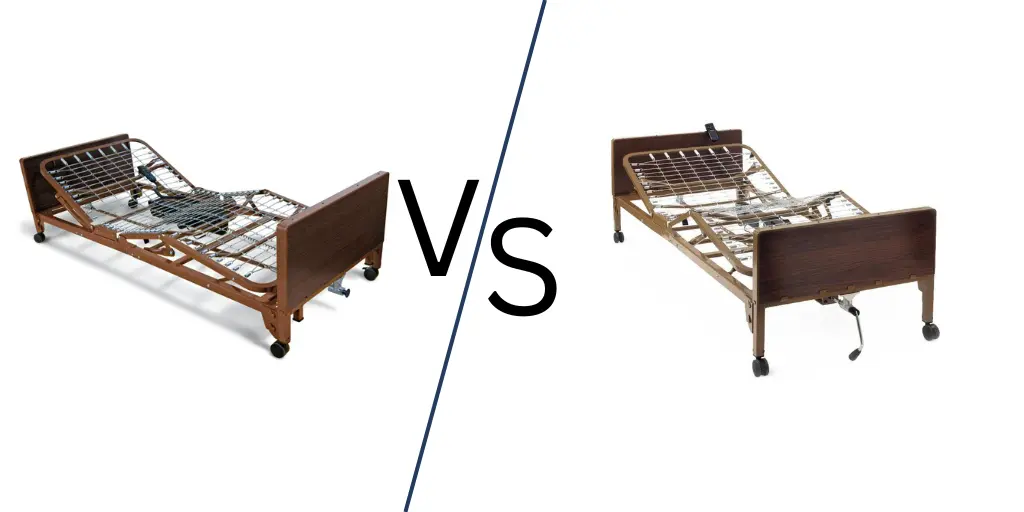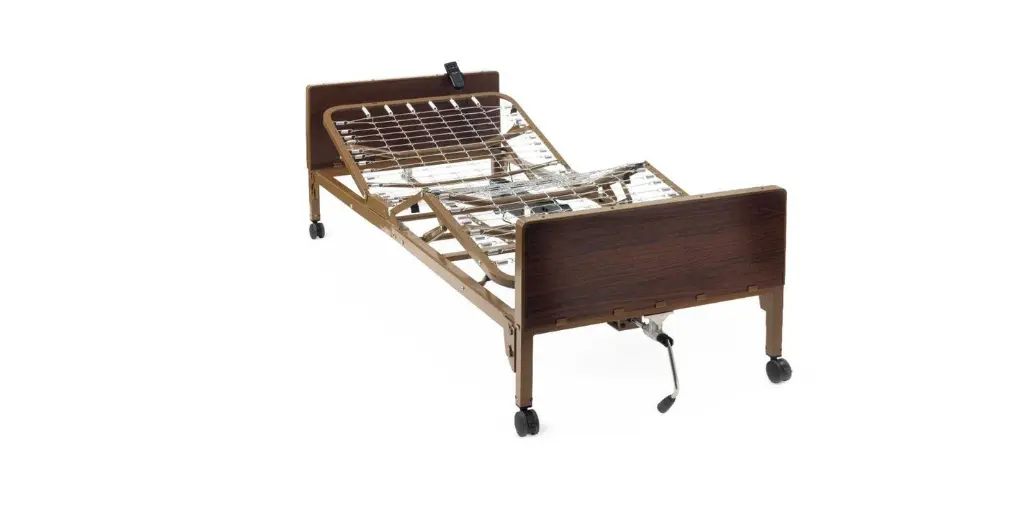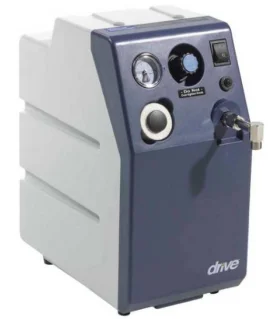Full Electric vs. Semi-Electric Hospital Beds: What's the Difference?
Choosing a home hospital bed is a critical decision that impacts patient comfort, independence, and caregiver safety. When researching options, the primary distinction you will encounter is between a Full Electric Hospital Bed and a semi-electric model.
While both types offer the convenience of electronic controls, a single key difference determines functionality, price, and suitability for long-term care: the method of adjusting the bed’s overall height.The main difference between them, which impacts their function, cost, and suitability for long-term care, lies in how the bed’s overall height is adjusted.

Key Takeaways
Electric vs Semi-Electric Hospital Bed
- The Semi-Electric Hospital Bed features an electric control for the head and foot sections, but requires a manual crank to raise or lower the bed height.
- The Full Electric Hospital Bed offers complete push-button control over the head, foot, and overall height (Hi-Low), maximizing patient independence.
- The semi-electric model is generally the more affordable, budget-conscious choice, while the full electric bed is preferred for long-term care and caregiver strain reduction.
The Semi-Electric Bed: The Cost-Effective Choice

The semi-electric hospital bed is the most common option for many home care situations due to its balance of features and affordability.
The term “semi-electric” means two of the three primary bed functions are powered:
- Electric Head and Foot: The patient or caregiver can easily raise and lower the head (Fowler’s position) and foot sections via an attached remote pendant. This is essential for comfort, eating, reading, and improving circulation.
- Manual Height (Hi-Low): The overall height of the bed platform is adjusted using a hand crank, typically located at the foot of the bed.
Who is the Semi-Electric Bed Best For?
The semi-electric hospital bed is the best choice when the medical necessity requires frequent changes in upper and lower body position but the overall bed height does not need constant electric adjustment.
This makes it ideal for:
- Short-Term Recovery & Post-Surgical Cases
The semi-electric model is effective for recovery periods lasting a few weeks to a few months such as:
A) Orthopedic Surgery (e.g., Hip or Knee Replacement): Patients recovering from these procedures require the ability to raise the head and feet (electrically) for comfort, edema management, and to help sit up without straining the surgical site. Since a dedicated caregiver is often present and the bed height may only need to be manually adjusted once or twice for safe transfer height, the semi-electric bed provides the necessary functionality without the higher cost of a full-electric model.
B) Acute Illness/Injury Recovery: When a patient is discharged from the hospital but requires therapeutic positioning for a short duration.
2. Respiratory & Cardiac Conditions (When Transfers Are Infrequent)
For chronic conditions that require the head of the bed to be elevated for medical reasons, the semi-electric bed meets the essential needs.
A) Chronic Obstructive Pulmonary Disease (COPD) or Severe Cardiac Conditions: These diagnoses often require the head of the bed to be elevated more than 30 degrees (Fowler’s position) to ease breathing, prevent aspiration, or reduce cardiac strain. The semi-electric bed offers effortless electric control for these life-sustaining adjustments.
B) Congestive Heart Failure (CHF): Patients with CHF often need their legs elevated or head raised. The electric head and foot controls manage this effectively.
When dealing with DME and insurance, knowing your coverage details is essential. You can learn more about Power Wheelchair accessories in our related guide, “Power Wheelchair Accessories: What Insurance Covers (and What It Doesn’t).”
3. Budget-Conscious Long-Term Care (With Strong Caregiver Support)
When financial constraints are significant, but the need for electric head/foot control is paramount:
A) Limited Budget: The semi-electric bed is significantly more affordable than a full-electric model, making it a strong option for budget-conscious users who still require motorized positioning assistance.
B) Dedicated, Strong Caregiver: This bed works well in situations where a strong, dedicated caregiver is always available to handle the manual height cranking without risking injury or excessive strain. The trade-off is the cost savings versus the minimal effort required for height adjustment.
The Full Electric Bed: Maximizing Independence and Safety

The Full Electric Hospital Bed provides complete automation, allowing both the patient and the caregiver to control every position with a remote control. This model offers the greatest flexibility, safety, and reduction of physical strain.
All-Powered Control (The Key Difference):
- Electric Head and Foot: Just like the semi-electric bed, the head and foot are controlled electrically.
- Electric Height (Hi-Low): The entire bed platform raises and lowers with the push of a button. This is the crucial difference, as it eliminates the need for manual cranking.
Why Choose a Full Electric Model?
- Patient Independence: Patients can raise or lower the bed themselves, making transfers to and from wheelchairs safer and easier.
- Caregiver Strain Reduction: Eliminating the manual crank dramatically reduces the risk of back injuries for caregivers, especially when the patient is heavier or requires frequent repositioning.
- Safety for Transfers: The ability to lower the bed very close to the floor reduces the risk of injury from falls during transfers.
- Preferred for Specific Severe Mobility Impairments: The electric height feature is nearly always required for patients with:
- Quadriplegia/Paraplegia (Spinal Cord Injuries): Where independent transfer is only possible with precise, remote-controlled bed height matching the wheelchair.
- Severe Arthritis or Fractured Lower Extremities: Where the patient must avoid straining and needs the bed height adjusted to place feet firmly on the floor before standing.
- Stroke Patients: Who often require the ease of a power transfer to aid rehabilitation and maintain independence.
- Long-Term Care: It is the preferred choice for long-term or complex conditions where frequent position changes are necessary.
| Factor | Choose a Semi-Electric Bed If… | Choose a Full Electric Bed If… |
|---|---|---|
| Height Adjustments | Infrequently needed (e.g., once or twice a day). | Required frequently for transfers or caregiving tasks. |
| Caregiver Strain | Caregiver is physically able to use the manual crank. | Caregiver has back issues or a physical limitation. |
| Budget | Budget is a primary concern (lower upfront cost). | Patient independence and caregiver ease are the priority. |
| Patient Independence | Patient can manage getting in and out of bed with a fixed height. | Patient needs to adjust bed height themselves for transfers. |
Before making your final selection, consider reaching out to Your Texas DME Experts at UniversalMed Supply. We can help you assess your specific care needs to ensure you get the bed that offers the maximum level of comfort, functionality, and safety.
Disclaimer: This information is for educational purposes only and should not replace professional medical advice. Always talk to your doctor or healthcare provider for diagnosis and treatment of any medical condition.
FAQs Electric vs Semi-Electric Hospital Bed
Q1: What is the difference between a Semi-Electric vs Full Electric Bed?
A: The core difference lies in the height adjustment. A semi-electric bed uses electric controls for the head and foot sections but requires a manual crank to raise or lower the bed’s overall height. A Full Electric Hospital Bed uses electric motors for all three functions: head, foot, and overall Hi-Low height.
Q2: Does a Full Electric Hospital Bed offer better comfort?
A: Both types offer the same powered comfort adjustments for the head and feet. However, a Full Electric Hospital Bed can be lowered closer to the floor (a safety feature) or raised higher with the push of a button, which significantly improves the comfort and safety of transfers for the patient and reduces physical strain for the caregiver.
Q3: Which type of bed is better for reducing caregiver strain?
A: The Full Electric Hospital Bed is vastly superior for reducing caregiver strain. Eliminating the manual crank means caregivers never have to strain their backs lifting or lowering the bed, making it the preferred choice for situations involving heavier patients or frequent transfers.
Q4: Is the cost difference between the two significant?
A: Yes, the cost difference is often significant. The semi-electric model is generally the more affordable option because it uses fewer motors and components. The Full Electric Hospital Bed requires a higher investment due to its complete automation
Q5: Does Medicare cover a Full Electric Hospital Bed?
A: Both types of hospital beds are classified as Durable Medical Equipment (DME) and can be covered by Medicare (Part B) when deemed medically necessary. However, coverage for the full electric model’s powered height feature sometimes requires more specific documentation justifying why the manual crank function of the semi-electric model is insufficient for the patient’s medical needs.



